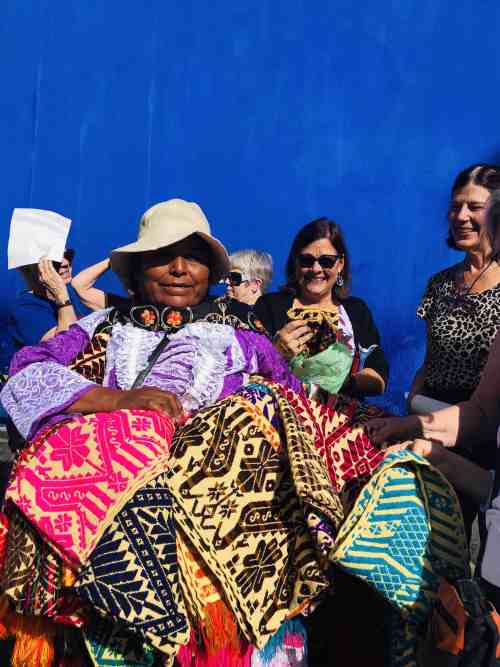Life in Teotitlan del Valle, Oaxaca, centers around life cycle events. Dia de los Muertos — Day of the Dead — brings us together at the village market to prepare our altars to welcome the difuntos — the spirits of our loved ones who return to earth to visit us each year.


This could be considered the most important observance in Oaxaca, especially in the villages, where customs and traditions that survived the Spanish conquest continue. The most money is spent on altar and gravesite decorations during Muertos than any other annual holiday, I’m told. It looks that way.


For days, the streets surrounding the market are closed to vehicular traffic. It is packed with people and vendors from the countryside. Backs of trucks and stalls are overloaded with oranges and apples, pineapple, sugar cane fronds, pecans and peanuts, skeleton beeswax candles adorned with handmade wax flowers, tapers, incense burners and copal incense.



At the molino (neighborhood mill) down the street from where I live, women wait in line with their baskets of ingredients to get their turn at the grinder. Their men — husbands, fathers, sons — wait out front by the truck, catching up on village business. The women will make and serve mole negro, mole amarillo, toasted garbanzo bean soup, or atole — the pre-Hispanic corn drink flavored with homemade chocolate and vanilla. All these need ingredients to be ground. The women bring their unique family recipes, generations in the making.



Ten of us are here for the Day of the Dead Women’s Creative Writing Retreat. We come to express ourselves through the written and spoken word. We write about memory and loss, mourning and grief, forgiveness of self and others. In our writing we honor our dead, we cherish what we have lost and in the process we give life to those who have left us.


The culture that celebrates death, celebrates life, says Octavio Paz. Here in Teotitlan del Valle, we are privileged to participate in a sacred ritual of celebration, memory and renewal of spirit.

We buy the ingredients to create our own altar, including those listed above. To this we add chocolate, mounds of marigold flowers, Pan de Muertos, mezcal and beer. We use a special quilted cloth made by Gretchen Ellinger who could not be with us. We bring photos of our dead to remember them. We remember them. We cherish their memories. We write about them, our feelings of loss, survival, making do without their day-to-day presence. We bring the practice of another culture closer to us to understand that there are different ways to approach life and death, as a continuum, as a process, as we examine and accept our own mortality, too.


I write about my father. It is my blessing to his memory, that his life informed mine and gave me meaning. I write about his love of coffee and cigarettes, how he quit, where he failed and endured, how he died. I write the vignettes of memory as a child turned adult. It is my portrait of him, my love for him, his quirks and idiosyncracies. This is my time to go beyond Oaxaca Cultural Navigator, into the depths of my family and my heart.


I savor Dia de los Muertos because of this. I think the women who are with me this week share in this sense of honoring our loved ones, discovering our voices, and giving words to feelings. As we said, we grieve many things: the loss of people in our lives, the loss of self as we age and change, the loss of circumstances that alter us, the loss of who we wish we had become and embracing who we are.

I’ll be writing more about this in days to come. Meanwhile, I hope you enjoy these photos of preparations. We were at the market today at 7:30 a.m. It was packed with people!


























































